On 5th September this year Nenad Bjelica was appointed as new head coach of NK Osijek. Bjelica last job was at Dinamo Zagreb and he made fantastic job there with some impressive performances in Champions League last season. When he came Osijek was sitting at 8th position with only 1 point from three matches. After his appointment, there was only one direction – towards the top. Bjelica managed to turn the bad start around and they were unbeaten in the first 11 games he managed in 1.HNL. In the 13 matches Osijek managed to win impressive 32 points from possible 39 points and scored 22 goals while conceding 9 goals. It is worth noting that he got a role as a manager which is rare in Croatian football which allowed him to get players he wanted leading to him signing Mario Jurčević, Damjan Bohar and Josip Vuković. All of them played a vital role in the team since their arrival.
In this tactical analysis, we will take a closer look into how Osijek looks in different phases of football game. We will highlight what his players tend to do more often and what he implemented into the tactics since he arrived at the club.
Formation and key players
In this section, we will see what formation Osijek mostly used and which players played crucial roles.
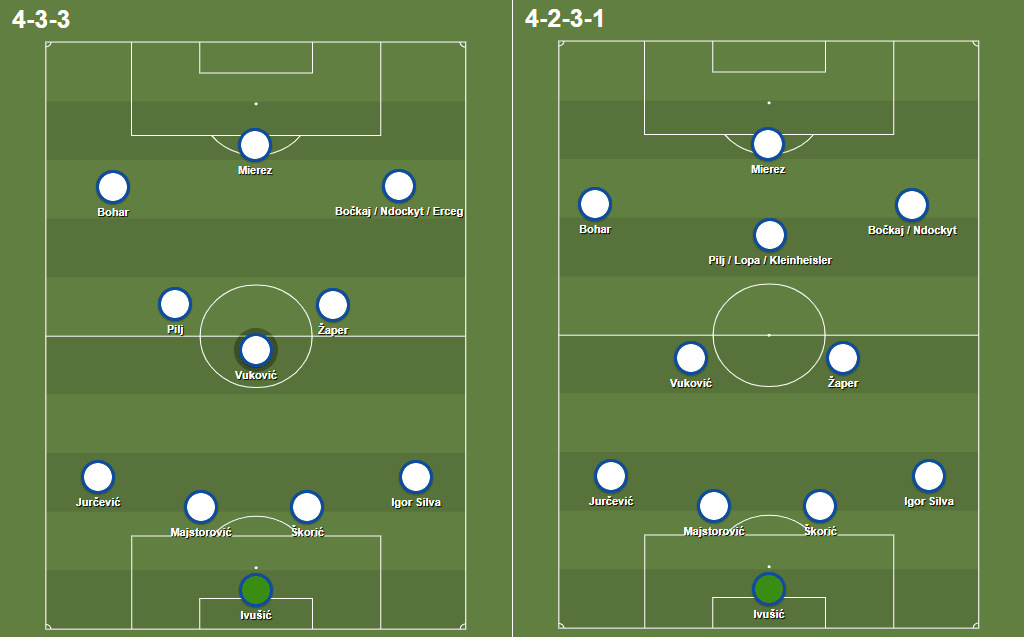
[image: ShareMyTactics]
Bjelica mostly used 4-3-3 and 4-2-3-1 formation. What rarely changed was their back four, along with Ivušić, Bohar and Mierez. Most rotations happened on right-wing and central midfield positions. On the right-wing Osijek has good depth because they can pick a player based on opponent and what would they try to accomplish in a certain match. Bočkaj could suit them as inside forward, Ndockyt gives them pace on the wing, while Erceg work rate and aggression are good qualities to support full-back in defensive phase. It could be said that that two central midfielders in role of ‘’8’’ are the players who do the most work for the team. Bjelica mostly used Pilj and Žaper because they are capable of playing in both directions on a high level, while Lopa and Kleinheisler are closer to playing as attacking midfielder and are not so responsible in the defensive phase.
When Lopa or Kleinheisler play they mostly switch in 4-2-3-1 formation which suits them more. Mierez is the main man in the attack and does a lot of work for his team by winning aerial duels and holding the ball while waiting for support after the long balls from defenders. Not only that, but Mierez tracks back and often helps defence. We can’t ignore the fact that Osijek has strong defence which isn’t rotated for a reason, Majstorović and Škorić are arguably the best centre-back pair in the league, while same can be said for Igor and Jurčević being probably the best full-back duo in the league. In the next section of this analysis, we will see how Osijek looks when they are in possession.
In possession – build-up and offensive tendencies
We will start from build-up. What Bjelica demands from his centre-backs is to play medium or long-range passes, avoiding playing simple short passes. Škorić is responsible to try and play a little more risky passes than Majstorović because he is on favourable right centre-back position, while Majstorović is slightly limited because he is also right-footed, but plays on the left. In the example below we will see one situation where Škorić makes progressive pass between the lines towards Bočkaj.
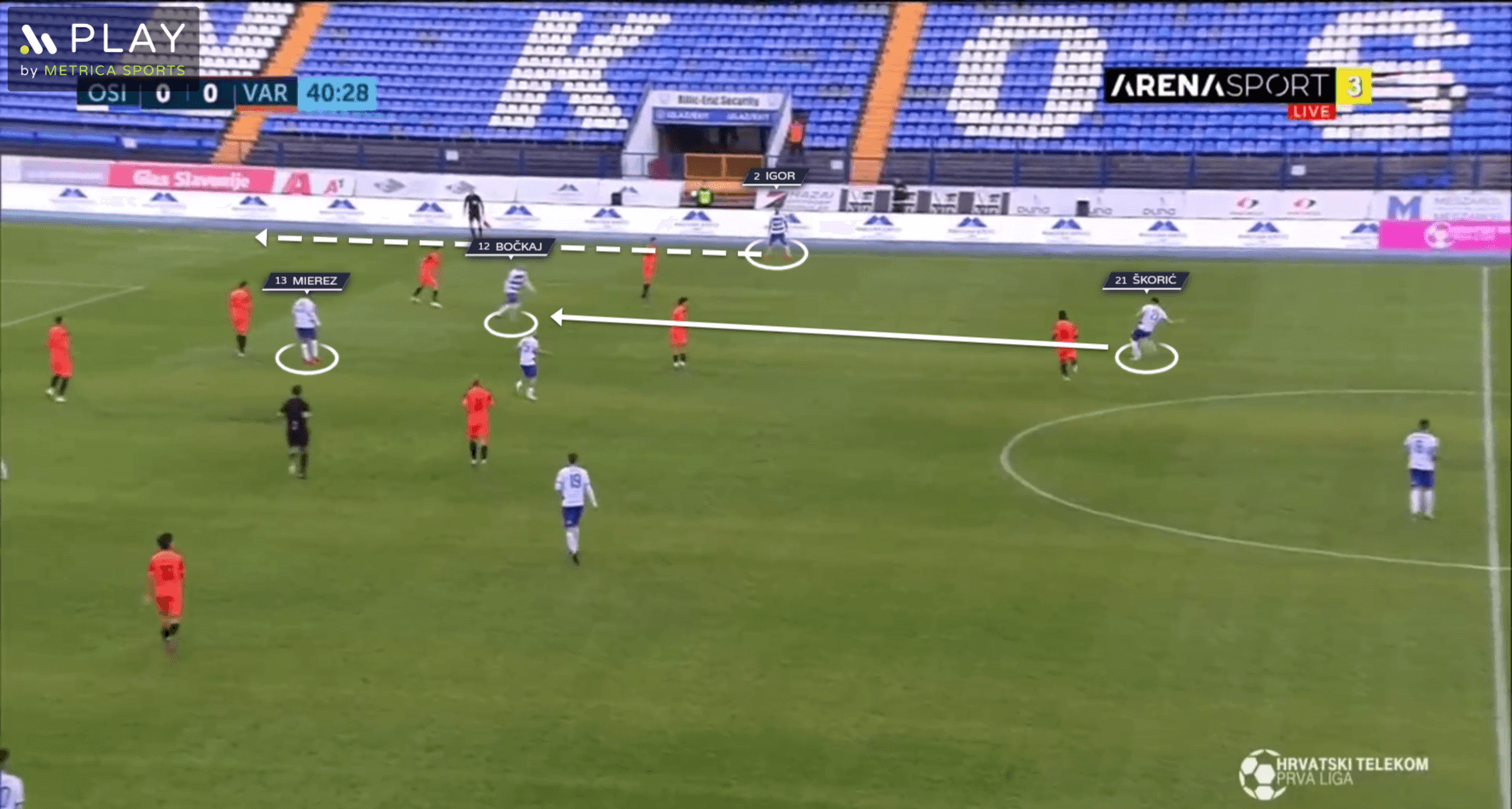
In this situation we can see that opponent was deep into their half which allowed Osijek centre-backs to get on opponents half looking for receiver between the lines. Bočkaj occupies half-space to offer solution between three players which also opens space for Igor run down the line into the open space. Škorić recognises that Bočkaj separated himself from his marker and makes a ground pass which Bočkaj can receive and has enough time to turn towards the goal.
It is important for Osijek that both centre-backs are capable of playing those passes. Mierez is marked on the image as well his body position puts centre-back near him in doubt because if he pops out to press Bočkaj and then Mierez can make a run behind unmarked. As well Igor with his run offers Bočkaj another option and Igor often does position himself high in the opponents half acting more as a wing-back.
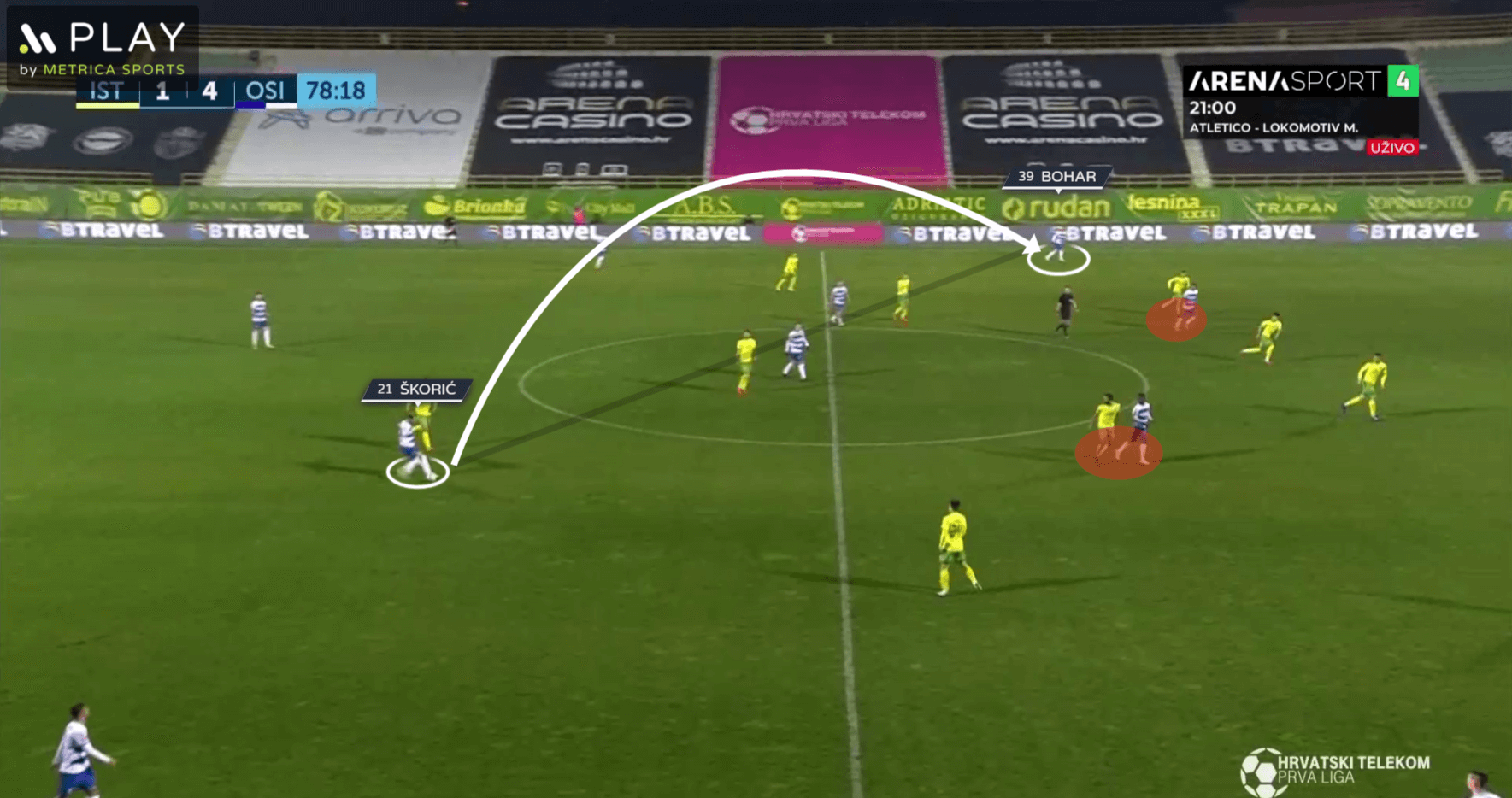
On the image above there is example what Osijek centre-backs do frequently when there is no open players to play progressive ground pass. As we can see that Mierez and Ndockyt are marked tightly by opponent and two midfielders are in shadow of opponent players and are ineligible to receive the pass. However Mierez run drawn attention from defender that should watch on left-winger and that movement enabled Bohar enough space to receive the long ball from Škorić. Both Škorić and Majstorović are responsible for distribution because their pivot doesn’t drop deep to receive the ball.
Both players in ‘’8’’ position roam and anticipate ball to the flanks to offer themselves for one-two or vertical pass to Mierez to be close for link-up play. Majstorović mostly plays passes towards Jurčević because Osijek mostly uses left side to attack. Reasoning is simple Jurčević and Bohar combine well and have great understanding, they are often supported by Pilj or attacking midfielder to create triangle. Below we will see two examples what they often do on the left side.
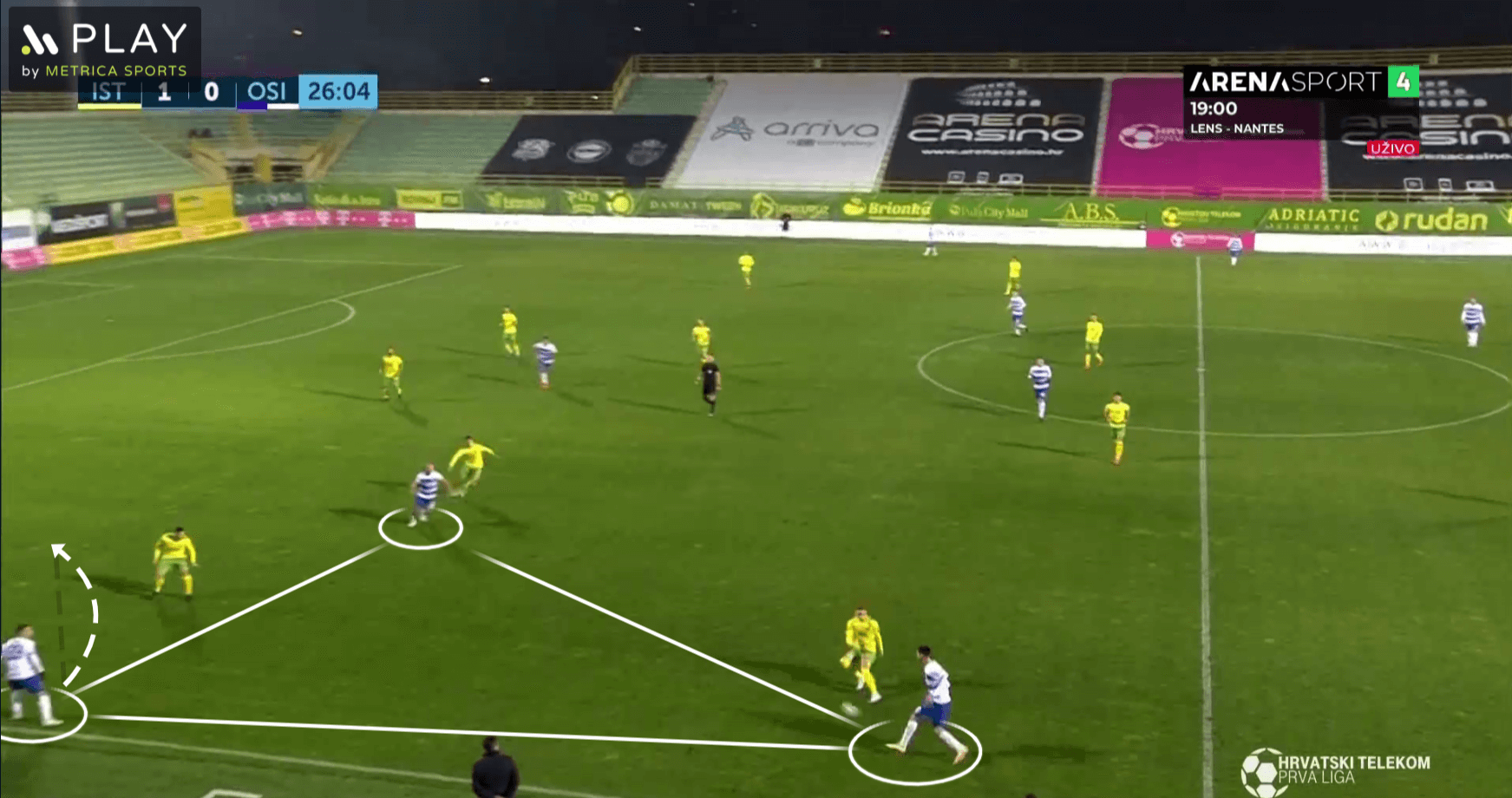
As we can see Jurčević received the ball from Majstorović and Pilj and Bohar are positioned to offer him two different solutions. Pilj occupies halfspace while Bohar is hugging touchline to draw his marker higher to open space behind him. Jurčević plays pass towards Pilj who could then make a flick into the space behind where Bohar could make run. It is not rare to see Jurčević chipping the ball over the full-back when Bohar draws him higher. Second example is when Bohar drops deeper to receive the ball.
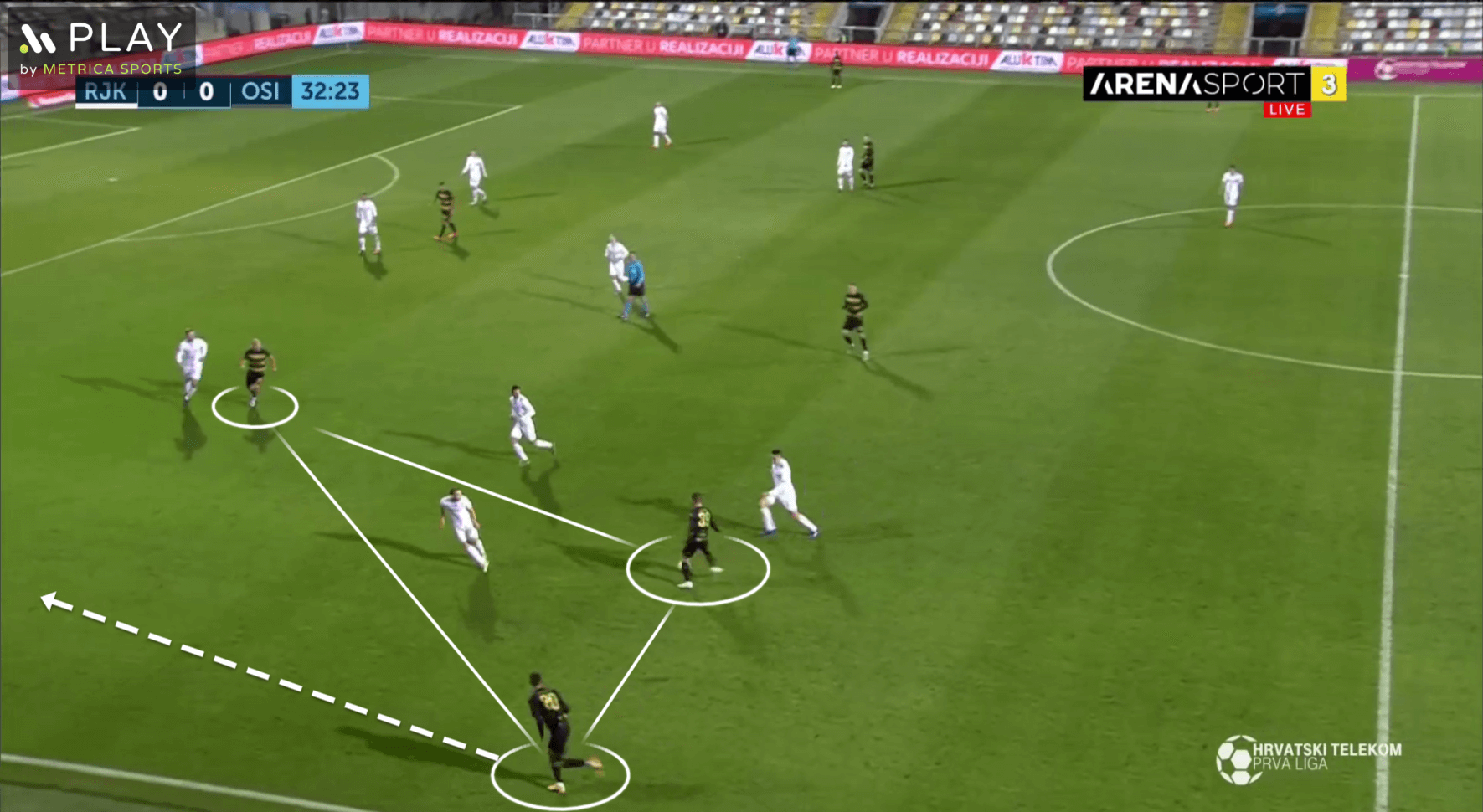
In this situation Bohar received the ball deeper leaving the space down the line open. When Bohar drops deeper to receive the ball, left central midfielder or attacking midfielder goes higher and occupies his place. These movements could catch opponent players out of their position and Osijek players look to exploit these situations into their advantage. At the moment Bohar passes towards the Pilj, Jurčević makes a run into the open space breaking free demanding the ball. Osijek often executes this action well which leads to crosses most of the time. On the right side of the attack, Osijek doesn’t combine that much as on left, but their right side is more dynamic Igor and Ndockyt or Erceg provide energy on the right side, meaning when Osijek combine well on the left side, Igor and right-winger are capable to close down far post by finishing their run in the opponent penalty area or near the opponent penalty area. Osijek often looks to switch flank towards Igor in order to isolate him to 1v1 with his marker. Igor isn’t ordinary full-back, he possesses fantastic ball control and dribbling combined with pace which allows him to beat his marker on regular basis.
Next situation shows how Osijek uses Mierez as the central figure of the attack.
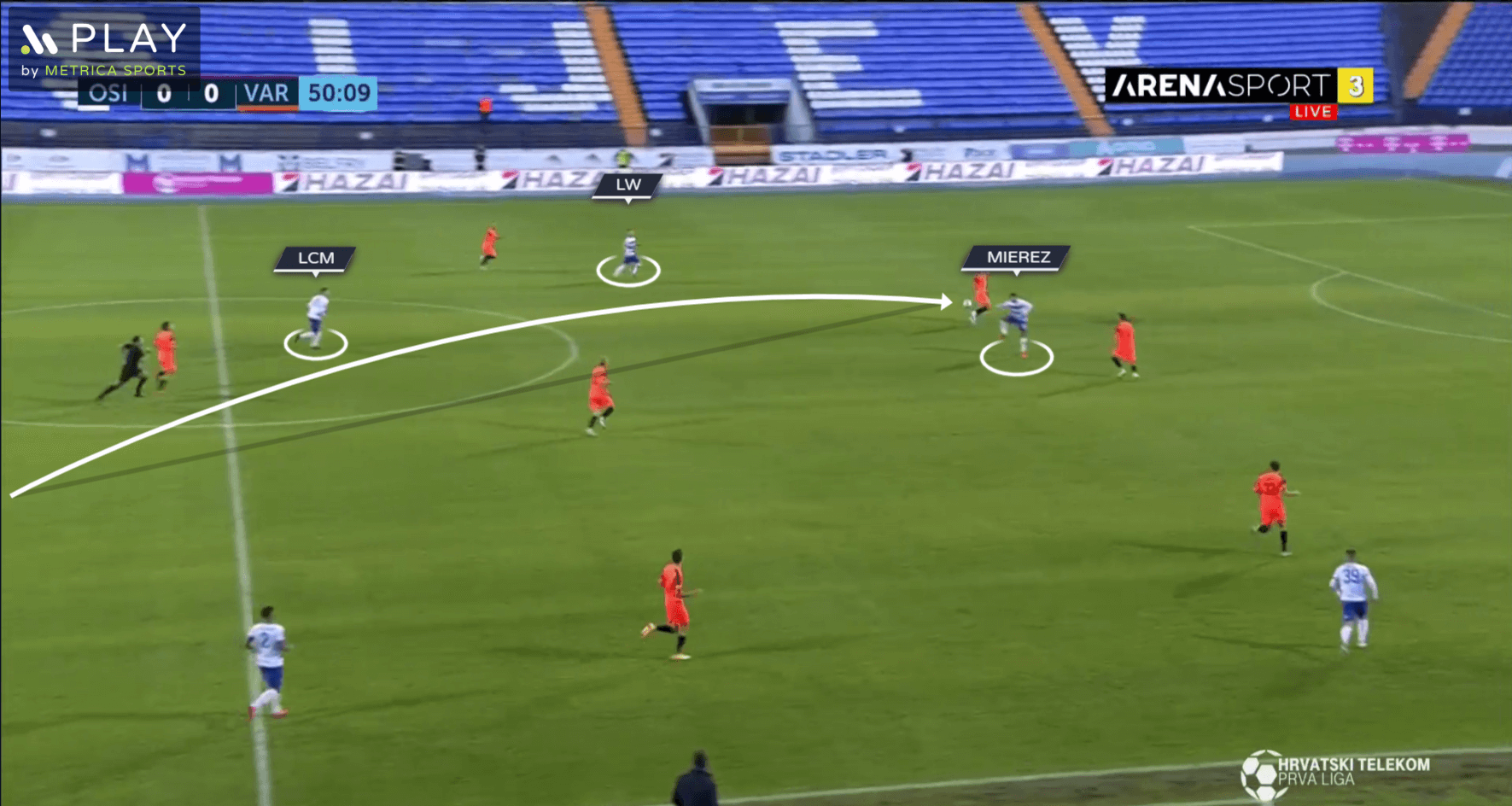
Osijek after regaining the ball instantly look where Mierez is positioned and they try to get the ball to him if possible. Mierez has great physical strength, feels comfortable playing with back towards the goal and he is strong in the aerial challenges. All those qualities help Osijek transition from defence to offence. Mierez draws a lot of fouls and he is brave enough to sacrifice himself for the team. In this situation, long ball is passed towards the Mierez after the team regained possession. We can see that while the ball was flying towards him, left central midfielder and left winger are running into the open space closer to Mierez to provide support. Mierez has the ability to recognise a situation and knows how to play a killer pass for his teammate, but also he is a good link-up option. There is frequently the situation that he is on his half when the ball is regained and Osijek is limited with their transition then if he is not open to receive the ball.
The last situation we will evaluate in this section is how Osijek acts in the final third.
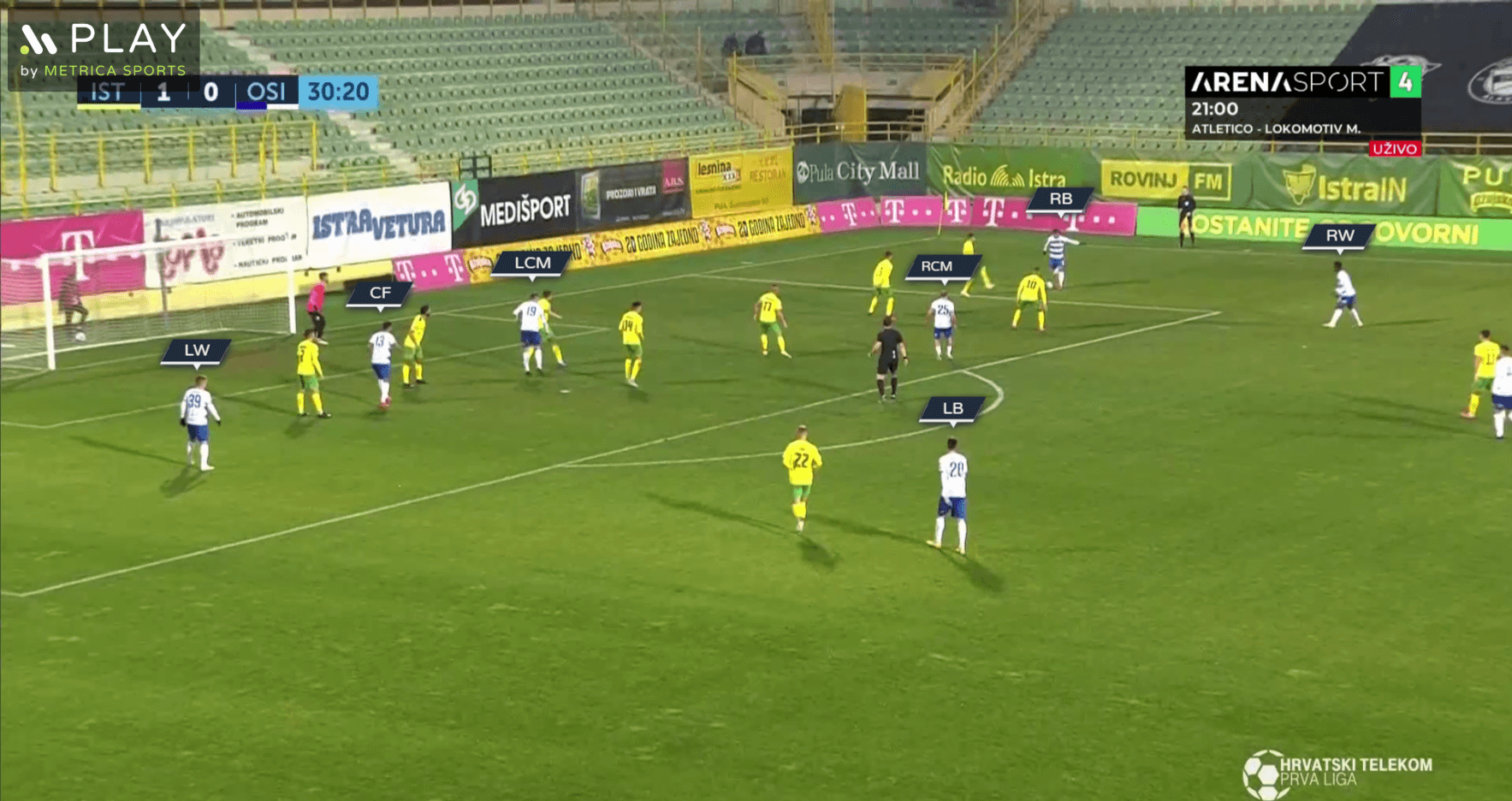
In the image above we can see one situation which ended with a headed goal by Mierez. However, the reason for showing this image is to display how Osijek arrives in the attack in numbers. Except ball carrier they always look to have at least 4 players in or around the penalty area, most of the time they are able to get with 5 along with ball carrier. We can see that both central midfielders are in the penalty area, both Žaper and Pilj are capable of scoring goals and they display high work rate in both directions. Through all the examples in this section, Osijek midfielders were not ball carriers, but they provided support in most of situations and they are covering a lot of ground which is crucial for Osijek playing philosophy. It is interesting to mention that left-back Jurčević frequently positions himself narrow in attacks from right side, something similar to Walker role in Premier League side Manchester City. Guardiola explained that positioning as best position for full-back to close down potential counter-attack. We will continue on this matter in the next section.
Out of possession
In this section, we will see how Osijek reacts to different situations when they are out of possession. We mentioned Jurčević positioning in the last example, which just shows that Osijek players are aware and ready for possible counter-attack. In the example below, we can see what mostly happens when the opponent makes counter-attack.
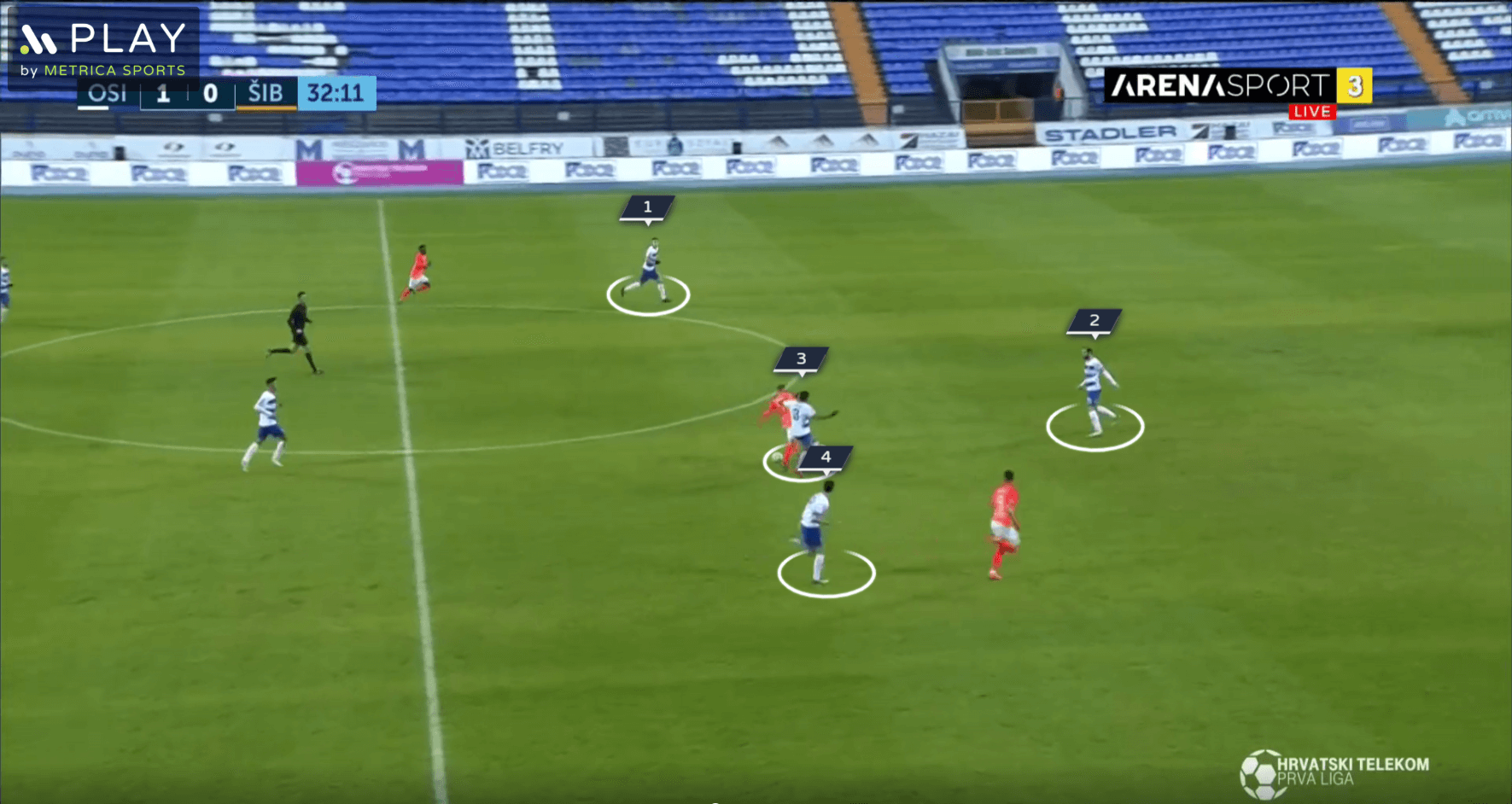
We saw that Bjelica demands that his players finish the attack with six players in or around the penalty area, but also that means that four players need to be ready for the opponent counter-attack. In the example above we can see that their opponent started counter-attack with three players, but Osijek prevented their attack with four players already in the defence. If the opponent waits for counter-attack with four players then Osijek would be ready to defend with five players, they always look to have one more player than the opponent in offence to defence transition. With mobile full-backs and hard-working midfielders at disposal, it is reasonable to give them the freedom to get forward, but train them to be aware of possible counter-attack and to be proactive. Next situation is how they position themselves in the middle block which is the most common way of their defence.
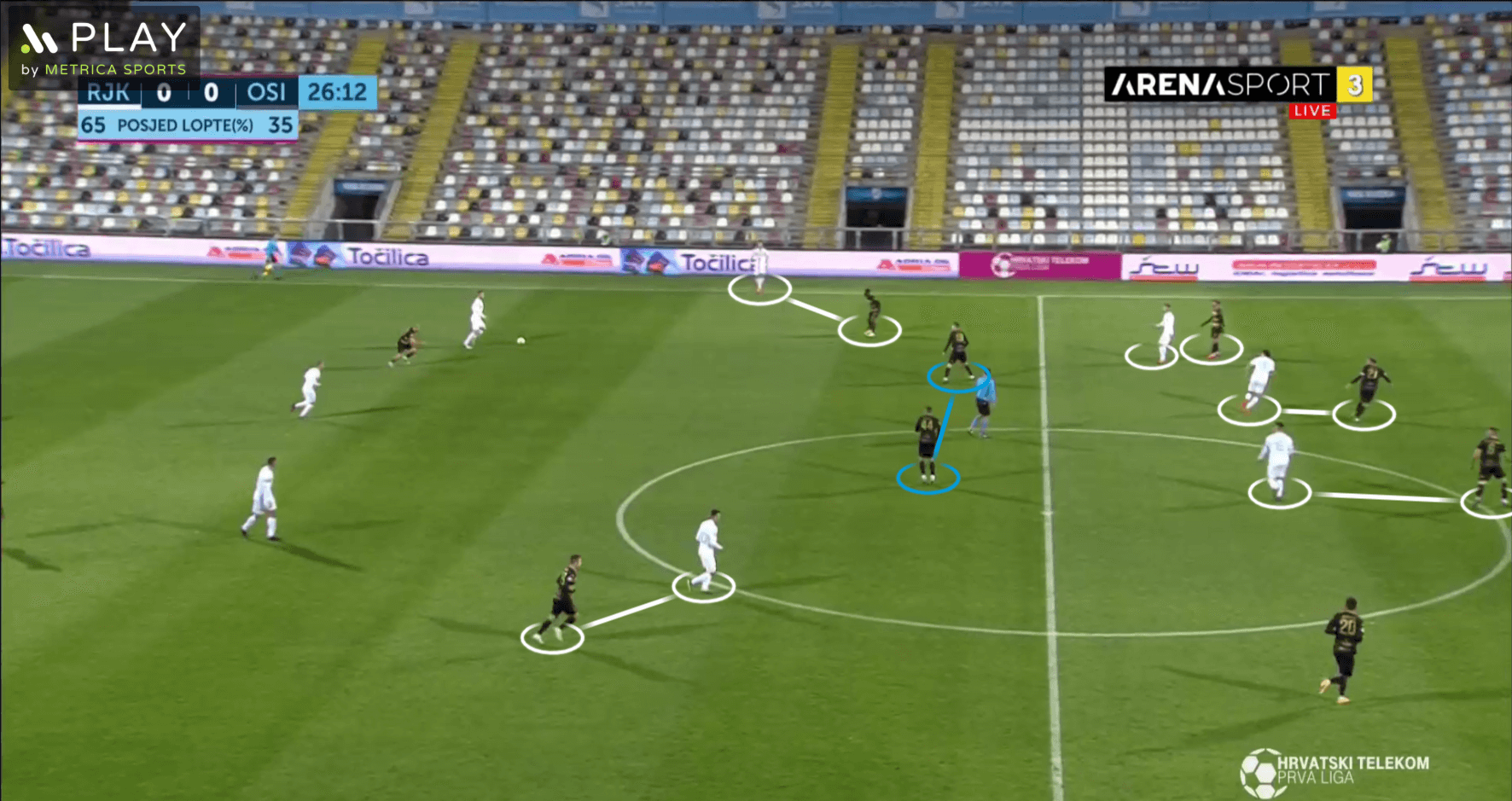
Only Mierez and Pilj made pressing on ball carriers while the rest of the team stand in the middle block. Osijek wingers are marking opponents on medium distance. We can see that Osijek defensive line stands high and both centre-backs and right-back are marking the opponent near them. It is good to mention how good is body position of both centre-backs showing that they are ready to run if the ball is attempted over them, but also if the ball is played to feet of the attacker they are ready to pop out and press him. Two midfielders are marked blue and they are on medium distance, their task is to cut passing lanes and prevent the ball progressing through the middle. If they are far too apart it could endanger their team, that is why Bjelica wants them to position themselves narrow while the opponent builds up from defence, pushing them to try long balls.
Last example will be on how Osijek operates in pressing higher up the pitch.
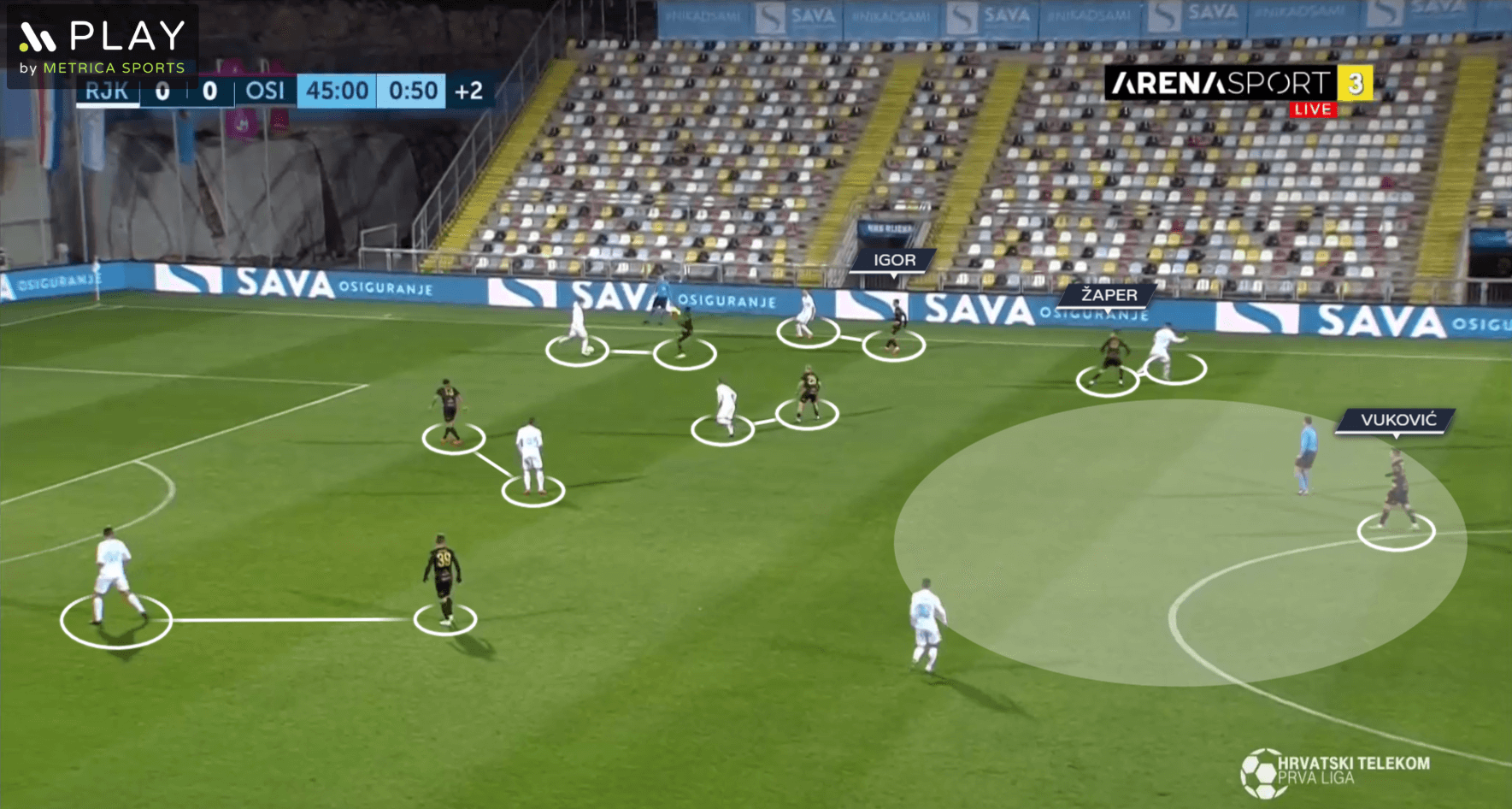
In this match they against the Rijeka who is the team that tries to build up from defence most of the time. Osijek managed to mark tightly opponent players close to the ball carrier. Centre-forward and left-winger are on medium distance from their player, but they are tying two players on them, we can see that Mierez(CF) is ready to press goalkeeper if the ball is played backwards, while then Bohar(LW) is able to press tightly his player. We can see that Igor positioned himself high to apply pressure and this is where Žaper spatial awareness is on point because he does a great job in recognising situation and covers Igor which is crucial in preventing pass down the line. In this situation, Vuković is slightly deeper and controls circled area which provides cover if the opponent succeeds to break through that he could react and try to regain possession or make a tactical foul which he doesn’t hesitate to do.
Conclusion
It is clear that Bjelica succeeded to implement certain patterns in Osijek tactics, but what he brought to the team is discipline and winning mentality. They had up and downs in their performances which is normal when you change coach through the course of the season, but now in winter break Bjelica will have time to prepare the team based on his preferences. Osijek shows big potential and they could grow a lot in attacking phase with already playing arguably the best defence in the league. It will be interesting to see if Bjelica can bring more from his players and make a push for the title this season.





Comments